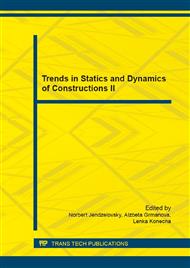[1]
CSA Standard A23. 3-04: Design of concrete structures, Canadian Standard Association, (2004).
Google Scholar
[2]
ACI 352. 1R-89: Recommendations for design of slab-column connections in monolithic reinforced concrete structures, American Concrete Institute, ACI-ASCE Committee 352, USA, 1988, 22 p.
DOI: 10.1061/40558(2001)69
Google Scholar
[3]
PN-EN 1992-1-1: 2004/AC: Eurocode 2, Design of concrete structures - Part 1-1: General rules and rules for buildings, European Standard, (2010).
DOI: 10.3403/03178016
Google Scholar
[4]
N.M. Hawkins, D. Mitchell, Progressive collapse of flat plate structures, Journal of the American Concrete Institute 76(7) (1979).
Google Scholar
[5]
G. Melo, P. Regan, Post-punching resistance of connections between flat slabs and interior columns, Magazine of Concrete Research 50(4) (1998).
DOI: 10.1680/macr.1998.50.4.319
Google Scholar
[6]
Y. Mirzaei, Post-punching behavior of reinforced concrete slabs, School of Architecture, Civil and Environmental Engineering, EPFL, Switzerland, (2010).
Google Scholar
[7]
J. Sagaseta, A. Muttoni, M. Fernandez Ruiz, L. Tassinari, Non-axis-symmetrical punching shear around internal columns of RC slabs without transverse reinforcement, Magazine of Concrete Research, Paper 1000098, UK (2011), 17 pp.
DOI: 10.1680/macr.10.00098
Google Scholar
[8]
B. Wieczorek, Influence of the location of the column on the load capacity of a slab-column connection for the inner column after punching, Procedia Engineering 57 (2013) 1251-1259.
DOI: 10.1016/j.proeng.2013.04.158
Google Scholar
[9]
M. Wieczorek, Influence of amount and arrangement of reinforcement on the mechanism of destruction of the corner part of a slab-column structure, Procedia Engineering 57 (2013) 1260-1268.
DOI: 10.1016/j.proeng.2013.04.159
Google Scholar
[10]
M. Wieczorek, Investigations concerning the corner part of the reinforced concrete structure in the emergency of removing the corner support, Procedia Engineering 65 (2013) 135-142.
DOI: 10.1016/j.proeng.2013.09.023
Google Scholar
[11]
M. Wieczorek, Concept of shell-beam model of slab-column connection based on analysis of the 3D model . Procedia Engineering 65 (2013) 158-165.
DOI: 10.1016/j.proeng.2013.09.026
Google Scholar
[12]
B. Wieczorek, Idea of a simplified model to determination of the load capacity of an inner slab-column connection after its punching, Procedia Engineering 65 (2013) 126-134.
DOI: 10.1016/j.proeng.2013.09.022
Google Scholar
[13]
B. Wieczorek, Load-bearing capacity of reinforcing bars in the zone of the slab-column connection determined experimentally and in the result of numerical calculations, Procedia Engineering 65 (2013) 149-157.
DOI: 10.1016/j.proeng.2013.09.025
Google Scholar


